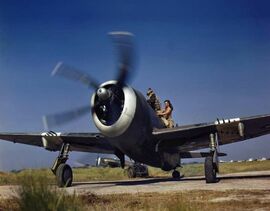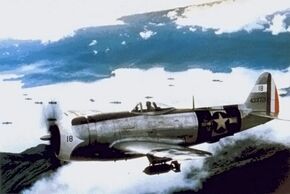The P-47 Thunderbolt was a single-seat fighter that was used by the United States during World War II.
Description[]
The first production model of the P-47 series, was the P-47B with an air-cooled, Pratt & Whitney R-2800-21 Engine that was capable of propelling the "Jug" at speeds of up to 643.7 km/h. The P-47 had a wingspan of 12.1 meters and a total length of 10.6 meters. The aircraft is in many ways similar to its German counterpart, the Focke Wulf Fw 190, though perhaps distincting the P-47 is the fact that P-47 the heaviest, single-seat, piston-engine powered fighter ever made.[2]
The P-47 maintained a maximum range of about 722 kilometers, restricting its ability to escort long-range American bombers all the way to their target. However, its service ceiling was certainly suitable for such operations, maxing out at about 12.9 kilometers. To achieve its high-altitude performance, the P-47 made use of the General Electric A-13 turbosupercharger placed behind the cockpit to maintain center of gravity and connected to the engine through a series of ducts. One of the issues that arose from having such a powerful engine, was that it required an equally large, four-bladed propeller, something that meant there was little clearance for take off, a problem that was solved by having a telescoping gear leg system that extended an extra 22 centimeters when lowered.[2]
The armament of the Thunderbolt consisted of eight wing mounted 12.7mm Browning M2 Machine Guns, four per wing. At the time of the P-47B's production, the provision for bombs or rockets was not implemented, though this would be added in subsequent models. While the P-47B was often criticized for not being maneuverable and struggling to climb to altitude, it was praised by pilots for its ability to survive crippling damage.[3]
Variants[]
Base Variants
- P-47C-1: Airframe lengthened to 11 meters for better maneuverability.
- P-47C-2: Featured center hard point for mounting 227 kilogram bomb
- P-47C-5: Had a vertical radio mast instead of the previous sloped example

P-47s of the 78th Fighter Group at Duxford, 1944
- P-47D-1: Had added cowling flaps, extra pilot armor, and new radio mast. Was the first P-47 to be built from the Evansville plant.
- P-47D-2: Modifications made to fuel system
- P-47D-3-RA: Similar to P-47D-2-RE/D-2
- P-47D-5: Small changes made to fuel and hydraulic systems
- P-47D-6: Could fit a bomb or drop tank
- P-47D-10-RE: Further changes made to hydraulic systems and new General Electric C-23 turbosupercharger fitted
- P-47D-11-RE/RA: Fitted with new R-2800-63 engine
- P-47D-15-RE: Added ability to carry either three 227 kilogram bombs or two 453 kilogram bombs
- P-47D-16-RE: Could use 100/150 octane fuel
- P-47D-20-RE: Used a new R-2800-59 engine
- P-47D-21-RE: Used manual water injection and used the R-2800-63 engine
- P-47D-22-RE: Used new Hamilton 3.9 m propeller blades and A-23 turbosupercharger regulator
- P-47D-23-RA: Used Curtiss Electric propeller
- P-47D-25-RE: First P-47 to use the famous "teardrop" canopy. Increased oxygen supply and fuel capacity.
- P-47D-27-RE: Fuel system improvement
- P-47D-28-RE: Similar to D-25-RE, used Curtiss Electric propeller
- P-47D-30-RE: Featured ten mounts for HVAR rockets
- P-47D-35-RA/D-40-RA: Featured dorsal fin
- P-47G-1-CU: Identical to P-47C-1, built by Curtiss
- P-47G-5-CU: Identical to P-47C-5, built by Curtiss
- P-47G-10-CU: Identical to P-47D-1-RE, built by Curtiss
- P-47G-15-CU: Identical to P-47D-11-RE, built by Curtiss
- P-47M-1: Used R-2800-57 engine with CH-5 turbosupercharger. Fitted with airbrakes.
- P-47N-1-RE: Fitted with R-2800-57 engine and CH-5 turbosupercharger. Wingspan increased by 45 centimeters. Wingtips were square instead of rounded. Extra fuel capacity
- P-47N-5-RE: AN/APS-13 tail warning radar fitted. General Electric C-1 autopilot added.
- P-47N-15-RE: Fitted with bomb rack
- P-47N-25-RE: Similar to N-1, cockpit floor strengthened, fitted with autopilot
History[]
Development[]
The P-47 began its development in 1940 as a light fighter to build upon the frame of the P-43 Lancer. While effective at high altitude, the Lancer was considered inferior to contemporary fighters and thus dropped from service. The chief engineer of Republic was Alexander Kartveli who designed the AP-10 prototype that began the P-47 project.

A Thunderbolt Mk II readying for take-off in Burma, January 1945
The AP-10 used the Allison V-Ill0-39 engine and was armed with one M1919 Browning machine gun and one 12.7 mm Browning M2HB. The AP-10 proved promising and was designed in a time when the United States Army Air Corps was in desperate need for modern aircraft. As such, the prototype was further refined into the XP-47 and XP-47, the A model being a design made solely for performance testing. It was decided that the XP-47 design would need more armament, armor, and a host of other features. Taking advantage of the newly created Pratt & Whitney R-800-21 Double Wasp Engine, a new design, the XP-47B was created.
The XP-47B prototype made its maiden flight on May 6, 1941. Perhaps most astounding of the design was simply that it was so large. The XP-47B was twice as heavy as any of its contemporaries yet was still able to fly at a top speed of 663 kilometers per hour.[4] Hundreds were ordered before even a prototype was constructed. The XP-47B subsequently became known as the P-47B. The first batch of 171 P-47B Thunderbolts were completed in March, 1942 with the 56th Fighter Group receiving them by June. Production of the P-47 ramped up to such a degree that a new plant in Evansville, Indiana was required to keep up with demand. By December, the first P-47Cs were arriving in Great Britain. P-47s with RA in their designation were completed at the Evansville plant while P-47s constructed at Farmingdale were designated RE.
Combat Service[]
With the P-47s good altitude performance Eighth Air Force bombers being shot down in costly numbers, the P-47 was promptly assigned to the role of bomber escort, beginning in 1943. P-47Bs given to British pilots were designated Thunderbolt Mk Is, with sixteen squadrons operating in Burma being issued the Thunderbolt. The Thunderbolt's first engagement with German pilots occurred on April 15, 1943 with two Focke Wulf Fw 190 fighters downed after the battle. Using the natural weight of the aircraft, P-47 pilots quickly adopted dive tactics, gaining altitude before diving on enemy fighters and speeding away.

A P-47D-30 of the Mexican Expeditionary Air Force flying over the Philippines, 1945
However, if pilots were not careful, they could blackout from partaking in such a high-intensity maneuver.
P-47s did well in the ETO, claiming a 1:8 kill ratio and successfully being able to combat the deadly Focke Wulf Fw 190 fighter. The P-47 engaged on its first ground attack operation on November 25, 1943 with great success. The arrival of the P-51 essentially meant the end for the P-47 in the bomber escort role, leaving the ground-attack role open for it. In this role, the P-47 became famous for its ability to destroy almost all kinds of German armored vehicle, from half-track to heavy tank. In the Pacific, the P-47N was used to combat kamikaze aircraft with the last P-47 kill of the war being a Ki-84 on August 14, 1945.
Operators[]
As well as the USAAF, operators of the P-47 included the air forces of Australia, Brazil, France, the Soviet Union and Great Britain.[5]
References[]
- ↑ 1.0 1.1 1.2 1.3 http://www.wwiivehicles.com/united-states/aircraft/fighter/republic-p-47d-p47g-thunderbolt-fighter.asp
- ↑ 2.0 2.1 http://www.militaryfactory.com/aircraft/detail.asp?aircraft_id=76
- ↑ http://www.warbirdalley.com/p47.htm
- ↑ Bowman, Martin. P-47 Thunderbolt vs Bf 109G/K. Osprey Publishing (2008), Page 10
- ↑ Gunston, Bill. St Michael Aircraft of World War 2. Octopus Books. 1982. ISBN 0-86273-014-7 Page 182
| |||||||||||||||||||||||||||||||||||
